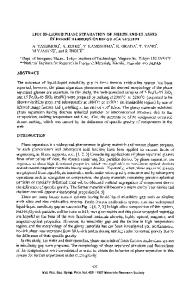Anomalous Phase Separation Behavior of Gel-Derived Soda-Silica Glasses
- PDF / 525,806 Bytes
- 9 Pages / 414.72 x 648 pts Page_size
- 6 Downloads / 388 Views
333
ANOMALOUS PHASE SEPARATION BEHAVIOR OF GEL-DERIVED SODA-SILICA GLASSES
GEORGE F. NEILSON AND MICHAEL C. WEINBERG Applied Mechanics Technology Section, Jet Propulsion Laboratory, California Institute of Technology, 4800 Oak Grove Drive, Pasadena, California 91109, USA
ABSTRACT The effects of retained bound hydroxyl groups on amorphous immiscibility behavior and on the kinetics of phase separation were studied in glasses containing from 10 to 19 percent sodium oxide prepared by the gel process. Differences in behavior as functions of preliminary thermal treatment of the gel precursor and of melting conditions were studied, employing IR spectroscopy, SAXS and WAXD to monitor the variation in glass microstructure. Both the initial gel treatment and the OH concentration in the prepared glasses were found to affect the immiscibility temperatures, and the magnitude of the maximum temperature increase was also a function of the sodium oxide concentration. It is suggested that the variation in thermodynamic behavior may be caused by the structural arrangement attained by the OH groups during the gel condensation process, which in turn affects the extent of hydrogen bonding to nonbridging oxygen ions.
INTRODUCTION
The gel process for preparing silicate glasses by the hydrolysis and polycondensation of tetraethyl orthosilicate has received intensive investigation in recent years [1,21. It has been found that the polymerization reactions that lead to the formation of -Si-O-Si- extended structures are strongly influenced by such factors as ratio of water to ethoxide in the reacting solution, pH of the medium, concentration of the reactants and nature of the solvents. These factors can also determine the dried material obtained by dehydration of the gel, the extent of network formation developed, the concentration and arrangement of bound hydroxyl groups and the residual concentration of unreacted ethoxy groups. Mukherjee, et. al. [3] found further that glasses obtained by melting dried gels can show different microstructure development and phase separation kinetics upon heat treatment than that found in glasses of similar composition made from a mixture of oxides, which indicates that some unique feature of the gel structure is "remembered" by the glass even after the melting process. These authors attributed this difference in behavior to the presence of hydroxyl groups formed during the gel process that are not removed during dehydration and are incorporated into the glass structure. More recent studies [4,5] have confirmed that increased water contents in phase separable glasses can profoundly increase both nucleation and growth rates, regardless of whether the water is introduced into the glass structure from the atmosphere above the melt or through the batch materials.
334 The studies cited above demonstrate that bound hydroxyl groups in a glass structure can markedly affect the phase separation kinetics. However, in one previous study of phase separation in a soda-silica glass of the same composition prepared b
Data Loading...










